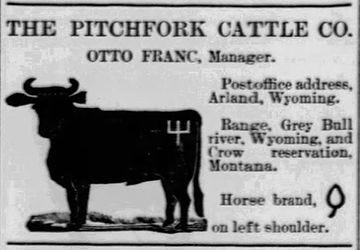Pitchfork Versus Pitchfork
A new lawsuit over the "Pitchfork" name and brand has ties to Texas Jack and the Wyoming ranching empire of one of his hunting buddies.
In the summer of 1878, Texas Jack Omohundro spent the better part of two months in the Wyoming wilderness with two guests, Otto Franc and Dr. Amandus Ferber. It was an eventful summer. They encountered Thomas Edison in Rawlins, where Texas Jack scared the preeminent scientist by shooting a weathervane on the train station from Edison's hotel room window to prove he was the "boss pistol shot of the West." They watched a total solar eclipse from their camp in the wilderness along the Wyoming-Colorado border/ Tip Vincent, the man Jack hired as his assistant for the trip, was ambushed and murdered by notorious bandit "Big Nose" George Parrott. They became possibly the first white men to visit the hot springs of present-day Thermopolis. And they explored the Big Horn Basin, where Franc asked the veteran cowboy Texas Jack if he thought the country was suitable for cattle ranching.


Franc was clearly taken with the region. Almost as soon as he got back home to New York City from his trip with Texas Jack, Franc divested himself of his interest in the produce import business he had built with his brothers and headed back to Wyoming to build a cabin on the Greybull River. He spent the cold winters of 1879 and 1880 in that cabin, and in the summer of 1880 began building the ranch houses and barns of his Pitchfork Ranch. He headed to Idaho and purchased a few thousand head of cattle, driving them south and crossing the Continental Divide at South Pass before turning north near Lander, crossing the Owl Creek Mountains, and driving up to his Pitchfork Ranch near present-day Meeteetsee.
The Pitchfork Ranch has been a permanent part of Wyoming's cattle kingdom since that day.
Last week, the Pitchfork Ranch in Wyoming was sued by the Pitchfork Land & Cattle Company, headquartered in West Texas since 1883 (but incorporated in Delaware). Both companies use similar logos, which the Texas Pitchfork claims to have used first.


The Texas Pitchfork alleges that by using the logo and name to sell cattle, beef, ranching services, and merchandise, the Wyoming Pitchfork is harming its brand. Further, the Texas company is asking the court to find the Wyoming company in violation of its registered trademark rights, forcing it to forfeit all sales and profits made using the Pitchfork name. In an interview with Cowboy State Daily, Pitchfork Ranch (Wyoming) manager Ben Anson said that the challenge would be finding documentation from the 19th century to support their claim to the Pitchfork name. My own research into the Pitchfork has uncovered the usage of the Pitchfork brand from as early as 1887, where Otto Franc used a crude drawing of the brand in his diary to keep track of cattle.
The earliest newspaper reference I can find is from the Montana Farming and Stock Journal of September 19, 1889, which lists that the Pitchfork Cattle Company sold 1,500 head of cattle to the Neideringhaus Brothers and their Home Land & Cattle Company. A subsequent appearance in the May 29, 1890 edition of the Billings Gazette of Billings, Montana, confirms both the name and brand were well established by this time.
The Pitchfork Ranch in Wyoming has been in the public eye for years. Following the death of Otto Franc in 1903, the ranch was purchased by L. G. Phelps. Phelps' son-in-law, Charles Belden, captured a series of photographs at the Pitchfork that exemplified cattle culture in the American West, and appeared in or on the covers of national magazines like National Geographic, the Saturday Evening Post, and Life. Twelve years ago, the Baker family purchased the Pitchfork, and have maintained it as a working cattle ranch operating around 100,000 acres.








